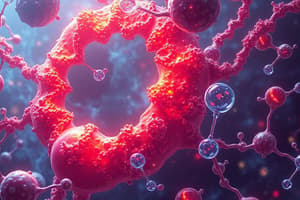Podcast
Questions and Answers
What are the four macromolecules and how do they compare in terms of energy content?
What are the four macromolecules and how do they compare in terms of energy content?
The four macromolecules are carbohydrates, lipids, proteins, and nucleic acids. Carbohydrates and proteins provide 4 calories per gram, while lipids provide 9 calories per gram.
How is food energy converted into chemical energy (ATP)?
How is food energy converted into chemical energy (ATP)?
Food energy is converted into chemical energy (ATP) through the process of cellular respiration, specifically in the mitochondria of cells.
What is the difference between saturated, unsaturated, and trans fats?
What is the difference between saturated, unsaturated, and trans fats?
Saturated fats have no double bonds between carbon atoms, unsaturated fats have one or more double bonds, and trans fats are unsaturated fats with trans-isomer fatty acids.
How does the body neutralize pH? What macromolecule would this impact most?
How does the body neutralize pH? What macromolecule would this impact most?
What are the two types of vitamins and how are they absorbed and removed from the body?
What are the two types of vitamins and how are they absorbed and removed from the body?
What is the difference between a food allergy and a food intolerance?
What is the difference between a food allergy and a food intolerance?
What are the four vital signs?
What are the four vital signs?
What vital sign changes would you expect to see in an athlete?
What vital sign changes would you expect to see in an athlete?
What vital sign changes would you expect to see in a newborn baby?
What vital sign changes would you expect to see in a newborn baby?
What is an electrocardiogram used for? What can the graph show?
What is an electrocardiogram used for? What can the graph show?
Explain how organs can stay alive for transplantation.
Explain how organs can stay alive for transplantation.
What kinds of disorders can be diagnosed on a complete blood count (CBC)?
What kinds of disorders can be diagnosed on a complete blood count (CBC)?
What is the central dogma of molecular biology?
What is the central dogma of molecular biology?
What is the goal of DNA barcoding?
What is the goal of DNA barcoding?
What are GloFish? How are they created?
What are GloFish? How are they created?
What is the overall goal of public health? What are some current public health concerns?
What is the overall goal of public health? What are some current public health concerns?




